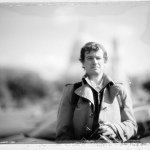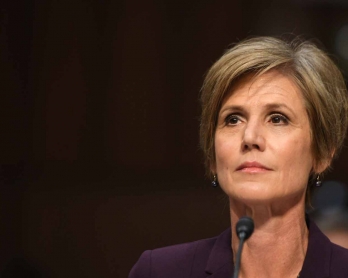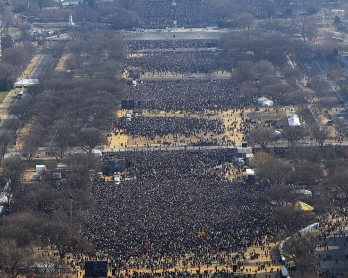Catching the bird
Sterling, Virginia, US -- People flashing the middle finger at the motorcade of the US president is not uncommon. What made this particular cyclist unique was her tenacity -- once the motorcade passed her, she managed to catch back up and share her feelings again.
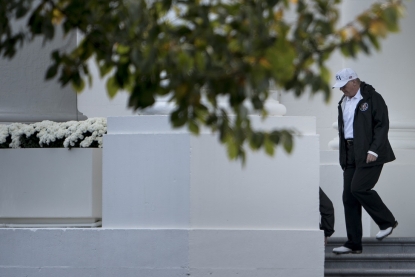 US President Donald Trump walks to his motorcade outside the White House in Washington, DC, before traveling to Trump National Golf Course on October 28, 2017. (AFP / Brendan Smialowski)
US President Donald Trump walks to his motorcade outside the White House in Washington, DC, before traveling to Trump National Golf Course on October 28, 2017. (AFP / Brendan Smialowski)As members of the White House traveling pool, AFP photographers are always with the president.
Given that we’re with one of the most powerful leaders in the world, much of our coverage is what we call protective.
For example, when we take off on Air Force One, we transmit a photo of the president, just in case there is an accident and it ends up being the last one of him.
When we are in the motorcade we keep our eyes open. You never know what you might see. You never know what might happen. When the motorcade is moving in regular traffic, there is more potential for trouble. I always take photos in such motorcades, just in case. Some end up being interesting or newsworthy, but most of them I don’t move.
President Trump is the third president that I have covered. Gestures -- be they middle fingers or thumbs-up -- have been common for all of them. But people tend to be especially passionate -- be it for or against -- this particular president.
 Supporters of Republican presidential nominee Donald Trump hold up signs as a motorcade with Democratic presidential nominee Hillary Clinton passes after a fundraiser on September 21, 2016 in Lake Mary, Florida. (AFP / Brendan Smialowski)
Supporters of Republican presidential nominee Donald Trump hold up signs as a motorcade with Democratic presidential nominee Hillary Clinton passes after a fundraiser on September 21, 2016 in Lake Mary, Florida. (AFP / Brendan Smialowski)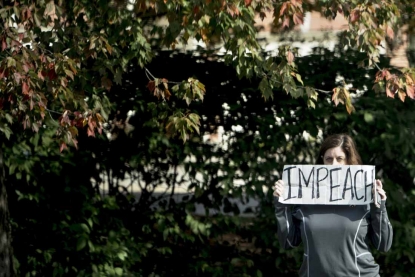 A protester holds an impeach sign outside the Trump National Golf Course as a motorcade with US President Donald Trump arrives in Sterling, Virginia, on October 28, 2017.
(AFP / Brendan Smialowski)
A protester holds an impeach sign outside the Trump National Golf Course as a motorcade with US President Donald Trump arrives in Sterling, Virginia, on October 28, 2017.
(AFP / Brendan Smialowski)
The motorcade that we were travelling in was what we call an off the record motorcade, leaving the Trump National Golf Course in Virginia. It’s the most low-key, stopping at red lights and generally obeying normal traffic rules. They use lights and sirens only as needed, doing their best to keep it quiet and incognito.
 US President Barack Obama's motorcade travels through McLean, Virginia as it heads to Walter Reed National Military Medical Center in Bethesda, Maryland June 21, 2016. (AFP / Brendan Smialowski)
US President Barack Obama's motorcade travels through McLean, Virginia as it heads to Walter Reed National Military Medical Center in Bethesda, Maryland June 21, 2016. (AFP / Brendan Smialowski)For regular people on the street, it can seem like you just have a bunch of really obnoxious drivers in front of you -- a wall of vehicles blocking an open road and not letting you pass. I remember one time during President George W. Bush’s time, there was one woman who kept wanting to pass and couldn’t. When the highway split, she was finally able to do so. She was furious, yelling and giving us the middle finger. But I feel it wasn’t politics, she was just frustrated at being delayed.
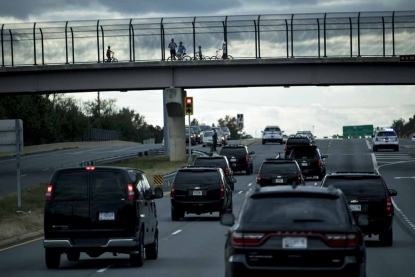 People watch from an overpass as a motorcade with US President Donald Trump drives after departing Trump National Golf Course October 28, 2017 in Sterling, Virginia.
(AFP / Brendan Smialowski)
People watch from an overpass as a motorcade with US President Donald Trump drives after departing Trump National Golf Course October 28, 2017 in Sterling, Virginia.
(AFP / Brendan Smialowski)But the woman cyclist in Virginia seemed to know exactly who was inside those vehicles. The picture that I sent is when the motorcade passed her the first time. It then blocked her way, as is normal for all traffic that it passes. So she went up on the sidewalk, caught up with us, hopped back on the road when it was stopped at a red light and then pedaled to the front, sharing her gesture with most vehicles a second time. I continued to take pictures, because at this point I wasn’t sure if security would view her as a risk and act.
Photographing out of a car window presents its own challenges. The world is moving by fast and the window glass can distort an image. In this case the windows were clean and distortion free. Plus we were going uphill, so I was able to have nicely composed photo.
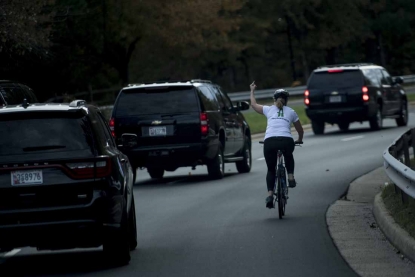 A woman on a bike gestures with her middle finger as a motorcade with US President Donald Trump departs Trump National Golf Course October 28, 2017 in Sterling, Virginia.
(AFP / Brendan Smialowski)
A woman on a bike gestures with her middle finger as a motorcade with US President Donald Trump departs Trump National Golf Course October 28, 2017 in Sterling, Virginia.
(AFP / Brendan Smialowski)Often taking images from a motorcade is your only chance to see the president that day. Other times it can be the only time that we see opposing points of view while travelling to an official event.
 US President Donald Trump and US first lady Melania Trump are seen in an armored vehicle as they travel from the Trump International Hotel to the White House October 28, 2017 in Washington, DC. (AFP / Brendan Smialowski)
US President Donald Trump and US first lady Melania Trump are seen in an armored vehicle as they travel from the Trump International Hotel to the White House October 28, 2017 in Washington, DC. (AFP / Brendan Smialowski)Over the years I have recorded many interesting and important images this way. Recently I photographed a veteran kneeling with a folded US flag.
 A man takes a knee while holding an American flag as a motorcade with US President Donald Trump drives to Indianapolis International Airport September 27, 2017 in Indianapolis, Indiana. (AFP / Brendan Smialowski)
A man takes a knee while holding an American flag as a motorcade with US President Donald Trump drives to Indianapolis International Airport September 27, 2017 in Indianapolis, Indiana. (AFP / Brendan Smialowski)Moments later I took a picture of a motorcycle police officer who fell while escorting the motorcade at high speed.
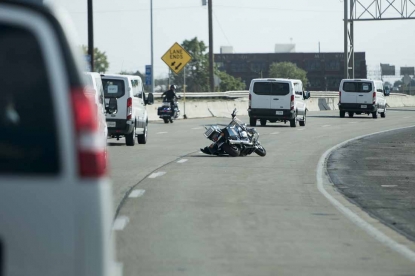 A police motorcycle is seen on the road after its rider fell while sorting a motorcade with US President Donald Trump to Indianapolis International Airport September 27, 2017 in Indianapolis, Indiana. (AFP / Brendan Smialowski)
A police motorcycle is seen on the road after its rider fell while sorting a motorcade with US President Donald Trump to Indianapolis International Airport September 27, 2017 in Indianapolis, Indiana. (AFP / Brendan Smialowski)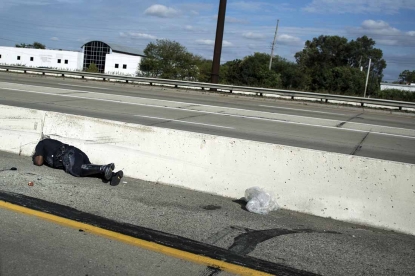 A police officer is seen on the road after falling from a motorcycle while sorting a motorcade with US President Donald Trump to Indianapolis International Airport September 27, 2017 in Indianapolis, Indiana.
(AFP / Brendan Smialowski)
A police officer is seen on the road after falling from a motorcycle while sorting a motorcade with US President Donald Trump to Indianapolis International Airport September 27, 2017 in Indianapolis, Indiana.
(AFP / Brendan Smialowski)
Over the years and three administrations, I have never received criticism of these photos from the White House. I don’t think they care.
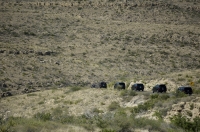
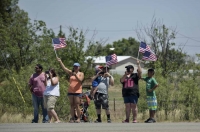
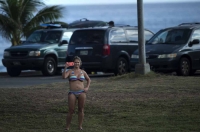
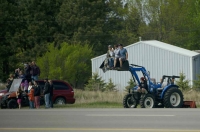
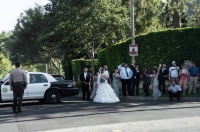
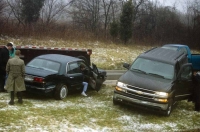
What’s interesting about this administration so far is how open it has been with photographers. President Trump has a famously adversarial relationship with the press. But the access that we have had so far with him has been much better than with President Obama, who often spoke about the importance of transparency.
The Obama administration closed access to official photo ops -- mostly the few seconds that you have to photograph at the start of a president’s meeting with someone -- very quickly in his first term. Many meetings that have been traditionally open to the press were now closed to us. You could sit at the White House all day and never see him. That administration was very controlling -- it wanted one view on Obama, a view provided by their official photographer.
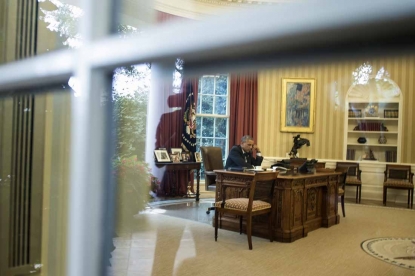 US President Barack Obama, seen through a window, speaks on the phone with King Abdullah II of Jordan in the Oval Office of the White House on August 8, 2014 in Washington, DC. (AFP / Brendan Smialowski)
US President Barack Obama, seen through a window, speaks on the phone with King Abdullah II of Jordan in the Oval Office of the White House on August 8, 2014 in Washington, DC. (AFP / Brendan Smialowski) A motorcade is seen reflected in glass as US President Barack Obama is seen in an armored vehicle while traveling to Hanauma Bay Nature Preserve to snorkel December 29, 2015 in Kailua, Hawaii. (AFP / Brendan Smialowski)
A motorcade is seen reflected in glass as US President Barack Obama is seen in an armored vehicle while traveling to Hanauma Bay Nature Preserve to snorkel December 29, 2015 in Kailua, Hawaii. (AFP / Brendan Smialowski)
With Trump, it’s been the reverse. Despite the president’s repeated tongue lashing of the media, his administration has opened up a lot of meetings and events to the photographers. Which has allowed us to do a better job.
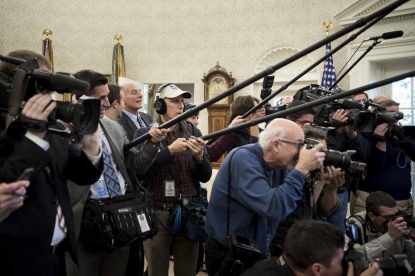 Photographing President Donald Trump at the Oval Office on October 27, 2017.
(AFP / Brendan Smialowski)
Photographing President Donald Trump at the Oval Office on October 27, 2017.
(AFP / Brendan Smialowski)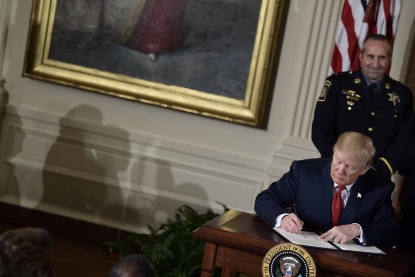 US President Donald Trump in the East Room of the White House on October 26, 2017.
(AFP / Brendan Smialowski)
US President Donald Trump in the East Room of the White House on October 26, 2017.
(AFP / Brendan Smialowski)


